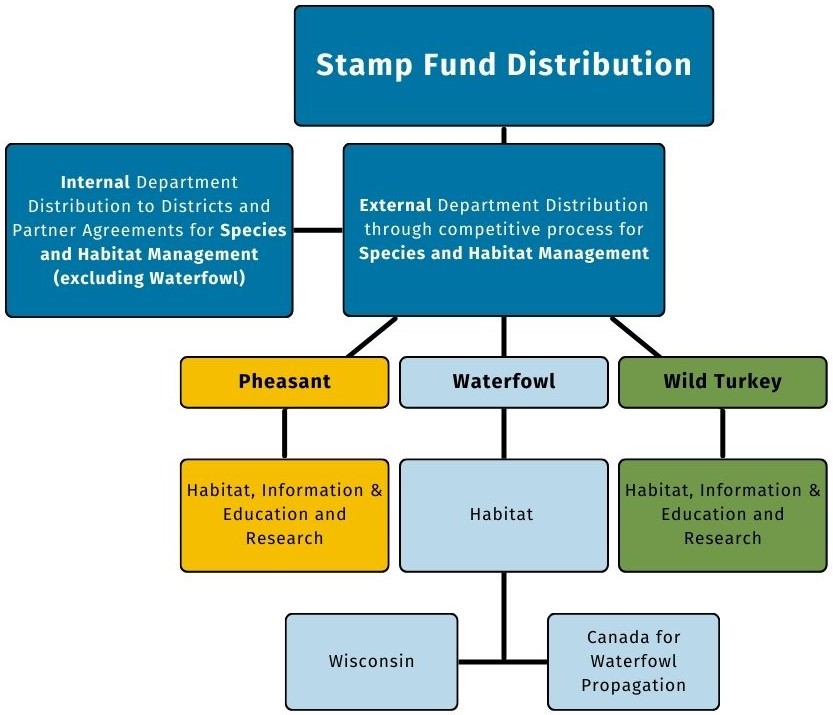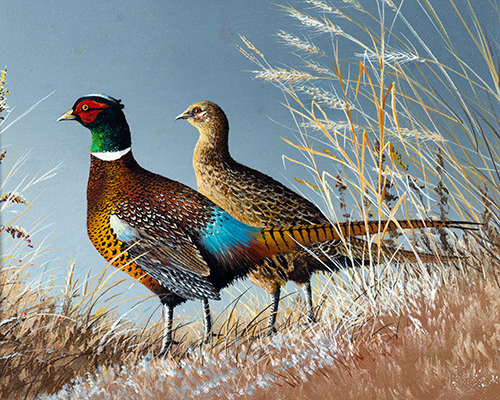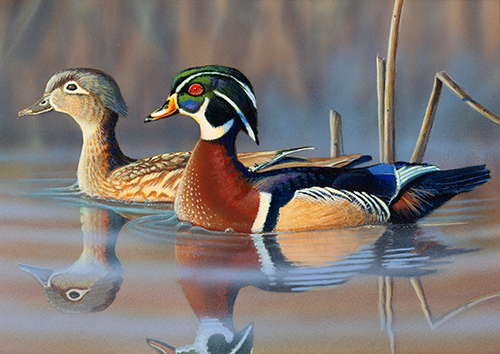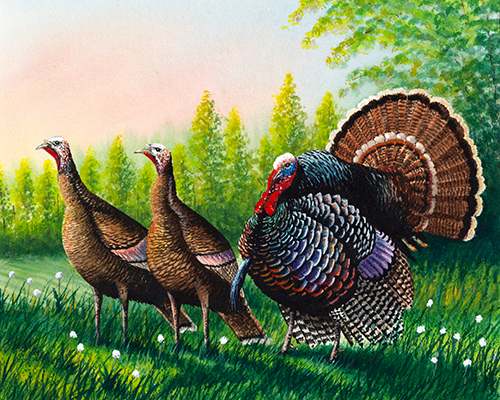Stamp Grant Opportunities and Application
Pheasant, waterfowl, and wild turkey hunters are required to purchase a species-specific stamp to legally harvest these game birds in Wisconsin. While hunters play a vital role in the success of these management programs, stamp collectors and outdoor enthusiasts also contribute greatly through the purchase of these beautifully illustrated pieces. The sales of these stamps generate significant revenue, amounting to hundreds of thousands of dollars each year. This collaboration between hunters, stamp collectors, and outdoor enthusiasts has been crucial in the sustained success of these species and these programs throughout the state.
Every other year, at the start of each fiscal biennium, different entities including units of government, state agencies (excluding Wisconsin’s Wildlife Management Program for Pheasant and Turkey), colleges and universities, school districts, tribal units of government, and private nonprofit organizations have the opportunity to expand efforts to obtain a portion of these stamp funds to benefit the species and expand the impact of these projects through applications to receive funding.
Select a specific species tab for more details on funding allocation and distribution.
Eligible projects encompass direct benefits to the habitat for pheasant, waterfowl, and wild turkey, as well as education and outreach and research activities for the benefit of pheasants and wild turkeys. To access detailed instructions on how to apply for these stamp programs, please refer to the "Application Information" tab below, where application guidance documents are posted. These documents outline the eligibility criteria for applicants, the types of projects that qualify for funding, and the process for obtaining and submitting an application.
Application Information
FY26/27 Request for Proposals
FY26/27 Applications
Pheasant
- Habitat [Download docx]
- Education and Information [Download docx]
- Research and Monitoring [Download docx]
Waterfowl
Wild Turkey
- Habitat [Download docx]
- Education and Information [Download docx]
- Research and Monitoring [Download docx]
FY26/27 Application and Submission Guidance
Pheasant
Waterfowl
Wild Turkey
Application Questions
For more information on stamp funding, contact:
- Pheasant: Mary C. Anderson, Grassland & Conservation Agriculture Specialist; 608-220-2935 or DNRWMPheasantStampFundApplications@wisconsin.gov
- Waterfowl: Adrian Coppage, Wetland Assistant/Financial Specialist; 608-228-7470 or DNRWMWaterfowlStampFundApplications@wisconsin.gov
- Wild Turkey: Krista Lutzke, Habitat Specialist; 920-851-7493 or DNRWMTurkeyStampFundApplications@wisconsin.gov
Pheasant
History of the Pheasant Stamp
Pheasant stamp funds have been providing opportunities for ring-necked pheasant management and hunting in Wisconsin since 1992. Starting in the fall of 1992, hunters statewide were required to purchase a Pheasant Stamp to hunt pheasants, and the resulting funds were first available for habitat and species management work in 1993.
In accordance with Wisconsin Statutes s. 20.370(1)(hr), pheasant restoration, 40% of the money received under s. 29.191(2), pheasant hunting stamp, shall be applied to "developing, managing, preserving, restoring and maintaining the wild pheasant population in the state."
The remaining 60% goes toward the management of the state game farm, which raises pheasants for release on public hunting grounds. Projects funded by pheasant stamp dollars along with countless partner dollars and efforts have managed, preserved and restored hundreds of thousands of acres of pheasant nesting, brood-rearing and winter habitat.
Today, a $10 pheasant stamp is required to hunt pheasants statewide. Besides hunters purchasing the pheasant stamp, many stamp collectors also purchase the stamp. On average, the pheasant stamp generates approximately $650,000 annually. This estimate includes an allocation from the conservation patron license sales.
How funds are allocated
Money from the pheasant stamp program is available to DNR personnel, conservation groups, organizations, tribes and other units of government. Habitat projects on public and private lands are eligible for funding, but individual landowners are not eligible to receive funds directly. To receive pheasant stamp funds, a project proposal must be submitted. The proposals need to include a project description, the estimated cost of the project, expected partner contributions and the requested amount from pheasant stamp funds.
Applicants are strongly encouraged to incorporate cost-sharing; cost-sharing with partner groups and other government agencies has stretched available dollars and allowed for pheasant stamp funds to be distributed to more projects.
When project proposals are received, DNR upland wildlife staff as well as members of the DNR Pheasant Advisory Committee review the projects and decide on recommended funding distributions. These allocations receive final approval from the DNR wildlife policy team. Project review and funding take place every two years, during the biennial budget process.
At the end of each biennium, any unspent money lapses back into the pheasant stamp account. Both an interim and a final accomplishment report are required from the project managers. These accomplishment reports outline the actual costs and progress of the project and also include the number of acres affected.
Working with partners
Cost-sharing is an important part of the pheasant stamp program. Over the years, Wisconsin's pheasant stamp program has been very effective at fostering cooperative relationships with local nonprofit organizations such as Pheasants Forever, Wings Over Wisconsin and other local conservation groups. These partnerships are beneficial because they stretch the available pheasant stamp dollars, thus allowing a greater number of projects to be funded.
In addition, working with partners allows pheasant stamp dollars to reach private landowners through technical assistance programs. From 1993 to 2022, more than $8.1 million has been contributed in cost-shared dollars. The pheasant stamp program continues to expand on these partnerships every year.
Accomplishments
Since 1993, the first year Wisconsin's pheasant stamp dollars were available, 543 projects have been funded benefiting the ring-necked pheasant. Allocated money from the pheasant stamp funds exceeds $11.1 million and has been matched by over $8.1 million in partner funds. These funds have affected 542,675 acres of both public and private lands.
Waterfowl
History of the Waterfowl Stamp
Waterfowl (duck) stamp funds have been providing opportunities for waterfowl management and hunting in Wisconsin since 1978. In accordance with Wisconsin Statutes s. 29.191(1)(b)1, the department shall expend 67% of the money received from fees for waterfowl hunting stamps for developing, managing, preserving, restoring and maintaining wetland habitat and for producing waterfowl and ecologically related species of wildlife.
The remaining 33%, in accordance with s. 29.191(1)(b)2, shall be used for the development of waterfowl propagation areas within Canada which will provide waterfowl that migrate through Wisconsin and throughout the Mississippi flyway. Money for the development of waterfowl propagation areas in Canada shall be provided only to nonprofit organizations.
Since European settlement, approximately half of Wisconsin's wetlands which waterfowl depend on, have been lost or degraded due to farming practices and development. The recognition of the loss of habitat and Wisconsin's importance to breeding ducks in the Mississippi flyway led some conservationists to create the state waterfowl stamp. The first price of the waterfowl stamp in 1978 was set at $3.25 and generated over $400,000 in the first year for waterfowl habitat work.
Today, a $12 waterfowl stamp is required to hunt ducks and geese statewide. Besides hunters purchasing the stamp, many stamp collectors and bird enthusiasts also purchase the stamp to support the conservation of waterfowl and wetland habitats.
On average, the waterfowl stamp receives annual revenues (including an allocation from the conservation patron license sales) of approximately $975,000, of which approximately $650,000 is allocated to Wisconsin waterfowl conservation work and approximately $325,000 is allocated and leveraged for Canadian Prairie Pothole waterfowl habitat conservation work.
How funds are allocated
Money from the waterfowl stamp program is available to DNR, conservation organizations, tribes, academic institutions and units of government. Habitat projects on public and private lands are eligible for funding, but landowners are not eligible to receive funds directly.
To receive waterfowl stamp funds, a project proposal must be submitted. A proposal needs to include several details, such as a project description, the estimated cost of the project, the location and the requested amount from waterfowl stamp funds. Applicants are strongly encouraged to incorporate funding contributions from other entities in proposed projects. Contributions from partner groups and other government agencies has stretched available dollars and allowed for waterfowl stamp funds to be distributed to more projects.
When project proposals are received, members of the Migratory Game Bird Committee review the projects and recommend funding allocations. These allocations receive final approval from the DNR Wildlife Leadership Team. Project review and funding allocations take place every two years, during the biennial budget process.
Project managers are to report progress annually and may make requests to carry over funding into the next fiscal year if necessary to finish committed project work. Due to the complex nature of wetland habitat projects (e.g. engineering, permitting, contracting, site conditions, etc.), waterfowl stamp projects take, on average, 2-3 years to complete after projects are approved for funding.
Not only do waterfowl stamp-funded projects benefit breeding and migrating waterfowl, but they also benefit other wetland-dependent wildlife such as amphibians, reptiles, shorebirds, invertebrates and native wetland plants. Waterfowl stamp projects also serve a valuable role in improving water quality by retaining floodwaters, recharging and filtering groundwater, trapping sediment and nutrients from surface water runoff, and providing aquatic habitats for people to recreate in.
Working with partners
Cost-sharing is an important part of the waterfowl stamp program. Over the years, Wisconsin's waterfowl stamp program has been very effective at fostering cooperative relationships with local nonprofit organizations such as Ducks Unlimited, Wisconsin Waterfowl Association and other conservation groups. These partnerships are beneficial because they leverage the available waterfowl stamp dollars, thus allowing a greater number of projects to be funded. A majority of waterfowl stamp projects occur on public lands.
However, partner organizations and units of government often serve an important niche by improving waterfowl habitat on private lands through land-use agreements with private landowners. Waterfowl stamp projects on private lands help produce more waterfowl and other birds that migrate through Wisconsin during the fall when hunters and bird watchers take to the marshes.
Accomplishments
Total stamp revenue from 1978 through 2024 was approximately $23 million. Since the inception of the state Waterfowl Stamp program, hundreds of projects have been funded to protect, restore, enhance and maintain wetland habitat. Between FY10 and FY24, more than 200 waterfowl stamp projects have been funded across the state.
In recent years, projects involving major maintenance of wetland infrastructure and wetland restoration in priority waterfowl habitat areas have been the highest priority for funding. The state of Wisconsin currently manages over 440 miles of the dike and over 1,100 water control structures across more than 1,000 impounded wetlands. Currently, waterfowl stamp funding alone is not capable of maintaining Wisconsin's wetland habitat or meeting wetland goals as outlined in the Upper Mississippi River/Great Lakes Region Joint Venture.
For more information on completed waterfowl stamp projects in Wisconsin and Canada, visit the waterfowl management webpage.
Wild Turkey
History of the wild turkey stamp
Wild turkey stamp funds have provided opportunities for wild turkey management in Wisconsin since 1996. In accordance with Wisconsin Statutes s. 20.370(1)(ht), wild turkey restoration, all money received under s. 29.164(5), wild turkey hunting stamps, shall be applied to "developing, managing, preserving, restoring and maintaining the wild turkey population in the state."
Hunters play a vital role in the success of the wild turkey management program by purchasing the wild turkey stamp, which provides critical financial support to the future of turkey management and hunting in Wisconsin. Since wild turkeys were first successfully reintroduced into Wisconsin in 1976, the population has increased and expanded statewide. Successful restoration of the wild turkey resulted from the tremendous hunter and landowner support, good survival and high-quality habitat.
Today, all turkey hunters are required to purchase the $5.25 wild turkey stamp to legally hunt turkeys in Wisconsin. In addition to the financial support provided by hunters purchasing the wild turkey stamp, stamp collectors also contribute to the funds generated through sales totaling approximately $750,000 annually for wild turkey stamp projects. This collaboration between hunters, collectors, and conservation organizations has been crucial in the sustained success of the wild turkey management program in Wisconsin. Proposed projects using wild turkey stamp funds must address the goals and objectives described within the wild turkey management plan.
Overall, the wild turkey stamp program has played a significant role in the restoration and management of wild turkeys in Wisconsin since its inception in 1996. Through the financial support it provides, the program ensures the continued success of wild turkey populations and the preservation of their habitat for future generations.
How funds are allocated
There are 5 designated Wild Turkey Stamp funding pools identified for the FY22/23 biennium. First priority in funding shall be given to projects with automatic allocations (described in detail on Page 2). The DNR Wildlife Management will receive automatic allocations for the statewide coordination of turkey management, for the Turkey Hunter Access Program and habitat projects with tailored amounts allocated by the district based on an analysis of the number of hunters, acres of public land and suitable habitat. The U.S. Forest Service will receive an automatic allocation for habitat development and management in the Chequamegon-Nicolet National Forest. Neither agency will be required to submit formal applications to the turkey advisory committee for these projects. However, district supervisors allocate funds for habitat work on a project-based basis, chosen projects will be presented to the turkey advisory committee at a future meeting.
Money from the wild turkey stamp program is available to DNR personnel, units of government, state agencies, colleges and universities, school districts, tribal units of government, and private nonprofit organizations. Each organization submits project proposals that align with the goals and objectives of the wild turkey management plan. These proposals are self-scored within the application process and undergo a thorough review process to determine their feasibility and potential impact on wild turkey populations.
Funds are allocated based on the total score, the merit of the proposed projects and their ability to contribute to the overall management and conservation of wild turkeys in Wisconsin. The Wisconsin Department of Natural Resources (DNR) in partnership with the Wild Turkey Advisory Committee's recommendations, oversees the distribution of funds and ensures that they are used in accordance with the designated purpose.
These allocations receive final approval from the DNR wildlife policy team. Project review and funding occur every two years during the biennial budget process. At the end of each biennium, any unspent money lapses back into the wild turkey stamp account. Both an interim and a final accomplishment report are required from the project managers. These accomplishment reports outline the actual costs and progress of the project and also include verifiable metrics.
Working with partners
Partnering, whether monetary or manual, is an important part of wild turkey stamp allotments. Wisconsin's wild turkey stamp program and funding recipients have been successful at fostering cooperative relationships with nonprofit and conservation groups, private landowners and units of government. Partnerships with these organizations have expanded the availability of wild turkey stamp dollars, allowing more projects to be funded and increasing the overall impact on the species and its habitat. From 1996 to 2022, over $16.6 million was contributed to wild turkey projects.
Accomplishments
Since 1996, the first year Wisconsin's wild turkey stamp funds were available, more than 1,200 projects have been funded benefiting the wild turkey. Allocated money from the wild turkey stamp exceeds $18.7 million, matched by over $16.6 million in partner funds, affecting more than 825,000 acres of public and private lands.




